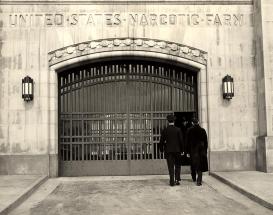The Narcotic Farm

Addiction Law, History and Public Policy Articles
Addiction Multimedia
Addiction Treatment History and Public Policy
Overview
Originally Published: 09/19/2014
Post Date: 01/08/2014
by JP Olsen and Luke Walden
Summary/Abstract
A historical video documentary of the infamous Federal Lexington Narcotic Farm in Lexington Kentucky founded in the thirties..
Content
The Narcotic Farm from Luke Walden on Vimeo.
The Narcotic Farm
2008 56 minutes
Produced and Directed by JP Olsen and Luke Walden. Narration and musical score by Wayne Kramer.
The Narcotic Farm is a historical documentary by JP Olsen and Luke Walden about a legendary and notorious federal prison/hospital/research center in Lexington, KY. The film premiered on public television in 2008 and continues to air occasionally on public television stations around the U.S.
In 1935, government scientists at the U.S. Public Health Service Narcotics Farm began a quest to discover a cure for drug addiction. Forty years later, this federal prison for the rehabilitation of drug addicts closed amid scandal over its practice of conducting drug research on convicts. Today, former inmates and doctors tell the story of what happened inside the Narcotic Farm.
Narrated and scored by former inmate Wayne Kramer of the radical 60s rock band the MC5, the film tells the story of this American institution through the voices of the former addicts who spent years locked within its walls. Astonishing, government-produced films and photographs take viewers inside the prison, highlighting its thriving jazz scene and revealing for the first time the experience of prisoners used as test subjects in its world famous drug research program.
Funded by the Independent Television Service and broadcast on public television across the United States in 2009.
The Lexington Narcotic Farm
In response to a growing need for drug abuse treatment facilities, the U.S. Congress in 1929 authorized the U.S. Public Health Service to establish two narcotic farms "for the confinement and treatment of persons addicted to the use of habit-forming narcotic drugs" (Public Law 70-672) (1). The first facility opened on May 25, 1935, outside Lexington, Ky. The 1,050-acre site included a farm and dairy, working on which was considered therapeutic for patients. The facility was built and run much like a minimum-security prison, with gates and window bars. This hybrid prison-like hospital or hospital-like prison continued after the name was changed to "U.S. Public Health Service Hospital" in 1936. The security features were removed when the facility was modernized in the late 1960s. With the increased availability of state and local drug abuse treatment programs, the hospital was closed in February 1974.
From its opening, the F1 had a research department. When the National Institute of Mental Health (NIMH) was created in 1948, this research unit was administratively separated from the Public Health Service hospital and became the first intramural research branch of NIMH, under the name Addiction Research Center. When the National Institute on Drug Abuse was created in 1974, the Addiction Research Center became its intramural research program. The Addiction Research Center has played a leading role in drug abuse research, under the initial leadership of Drs. Lawrence C. Kolb, Sr., and Clifton K. Himmelsbach. Prominent psychiatric researchers who spent time at Lexington include Drs. Abraham Wikler, Everett H. Ellinwood, Jr., Conan Kornetsky, Jerome H. Jaffe, Herbert D. Kleber, and George E. Vaillant. Among the research advances made at the Addiction Research Center were the characterization of acute and protracted drug withdrawal syndromes, recognition of Δ-9-tetrahydrocannabinol (THC) as the active constituent of marijuana, and identification of subtypes of opiate receptors (2). Treatment advances included methadone to treat heroin withdrawal, opiate antagonist therapy, and recognition of the role of conditioning in drug abuse relapse.





